Top Forex Brokers
The Rise of MT4: How MetaTrader Became the Market Leader
While brokers continue to add assets and broaden the choice for their traders, the retail trading scene remains dominated by three trading platforms without much competition. The past five years witnessed smaller FinTech firms launching improved alternatives but failed to gain significant traction. MetaQuotes, a Cypriot firm, maintains the retail-and-broker favorite MT4 trading platform. Its dominance is most evident in the Forex market, where it handles over 95% of the nearly $7 trillion-per-day Forex trading volume globally, excluding Japan. It was the first viable option for online trading, captured the trend in its infancy, and built a loyal broker client-base due to its reliable service. It launched in 2005 and fully supports automated trading, referred to as Expert Advisors (EAs), the fastest-growing trend across professional and retail sectors alike.
A Closer Look at MT4, MT5, and cTrader
Spotware Systems LTD, also based in Cyprus, launched a prominent MT4 competitor in 2010. Its cTrader became the primary choice for electronic communication network (ECN) brokers and traders, as its infrastructure supports connectivity to it. MT4, and its failed successor MT5, require a bridge to communicate with ECN. Demand from brokers for cTrader continues to rise but remains far behind MT4. Also, in 2010, MetaQuotes released MT5, intended as a successor to MT4, marketed as a viable multi-asset trading platform. The lack of backward-compatibility to the MT4 infrastructure and higher costs without significant benefits reduced MT5 to a failure. MetaQuotes ended official support for MT4, and some brokers continue to push MT5, with little success. The three trading platforms account for most of the retail trading volume, and this article compares the three against each other.
What makes MT4 so popular?
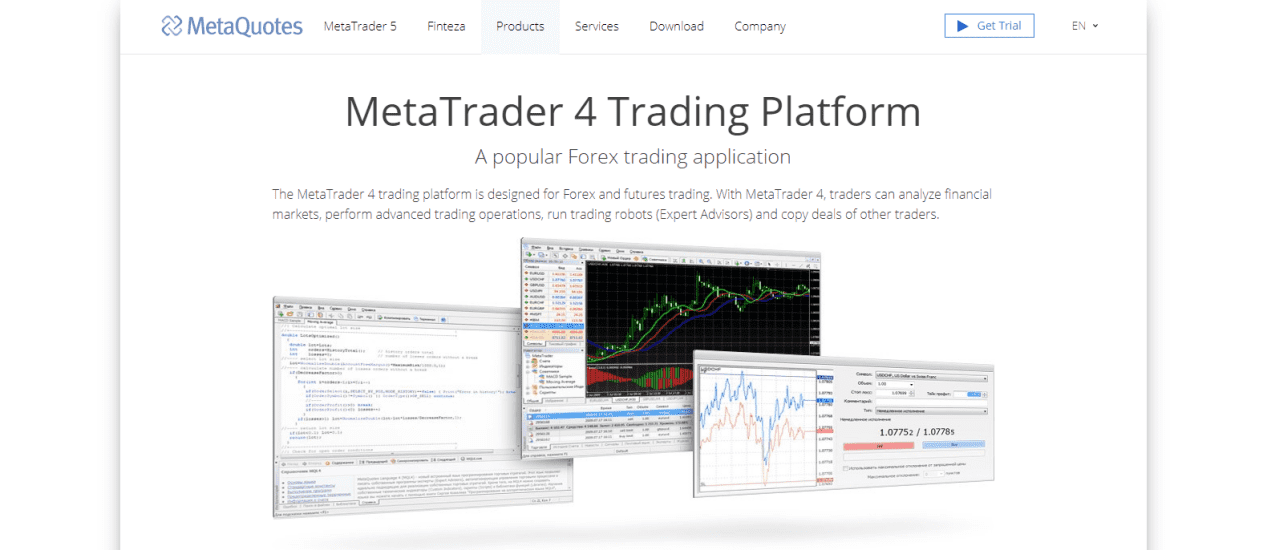
MetaQuotes released the MT4 trading platform in 2005, which continues to dominate the Forex market fifteen years later. Many have called for its demise, but no alternative has come close to dethrone the most versatile trading platforms available. Brokers enjoy its low acquisition cost with a full license available from $100,000, but many opt for a white label solution for as little as $5,000. It explains why over 1,200 brokers currently maintain the MT4 trading platform, but the most critical reason for its widespread success is the full support for automated trading solutions. The popularity and loyal support exist towards the MT4 infrastructure, rather than the out-of-the-box MT4 version, as available at most brokers, which represents a sub-standard trading platform.
It is essential to understand the difference between the often mis marketed MT4 version distributed by most brokers and the MT4 infrastructure that enables the necessary upgrades to MT4 to convert it into a market-leading cutting-edge platform. MT4 features 15,466 autonomous trading robots, or expert advisors (EAs), and 6,976 custom indicators. Many are free of charge, but traders should practice extreme caution. Proper upgrades cost as little as $50, which may expand to above $250, depending on the requirements of the trader. Competitive brokers offer an extensive upgrade package to the MT4, reducing or eliminating the costs to acquire third-party solutions.
MT4 requires EA development using its MQL4 language.
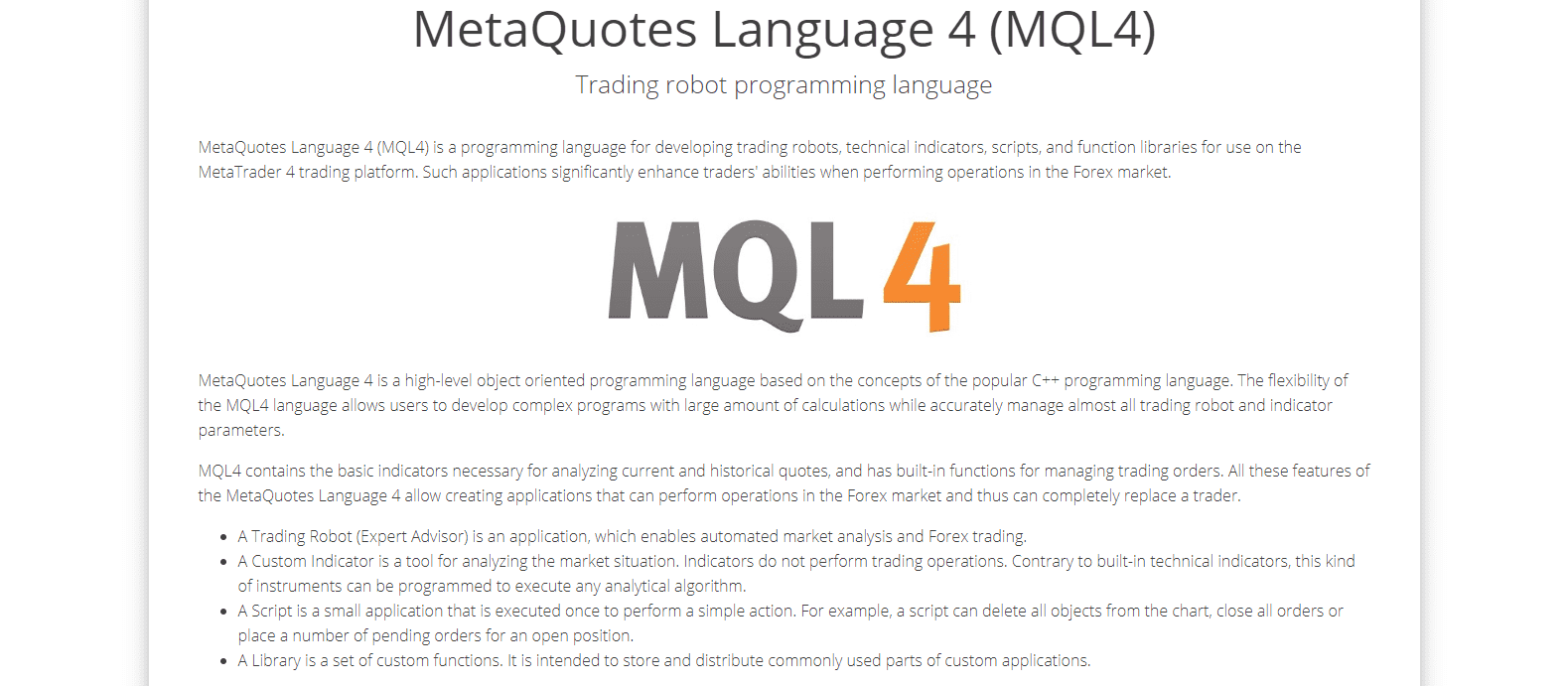
Manual traders are not ignored by MT4, which comes with nine timeframes, 30 built-in technical indicators, and 24 graphic objects. Tick charts, streaming news, and alerts allow traders to identify trading signals and calculate entry and exit levels. One-click and chart trading allows quick reaction to fast-moving markets via instant execution. Two market orders and four pending orders ensure proper trade and risk management, while a trailing stop is also supported. All necessary tools for manual traders are available, but the user-interface remains dated and unfriendly.
Aside from autonomous trading, social trading remains popular with retail traders, which MT4 supports via third-party add-ons. Enhancing the popularity of MT4 is the multi-account manager (MAM), enabling retail account management under the percent allocation management module (PAMM). Thousands of micro and small portfolio managers developed their business on the MT4 infrastructure. Many created custom indicators, EAs, and other custom solutions that require MT4 to function. The flexibility of MT4 continues to draw more users daily, and, therefore, the dominance is well-positioned to last. It has stood the test of time and earned the trust of tens of millions of traders around the world.
Why did MT5 fail?
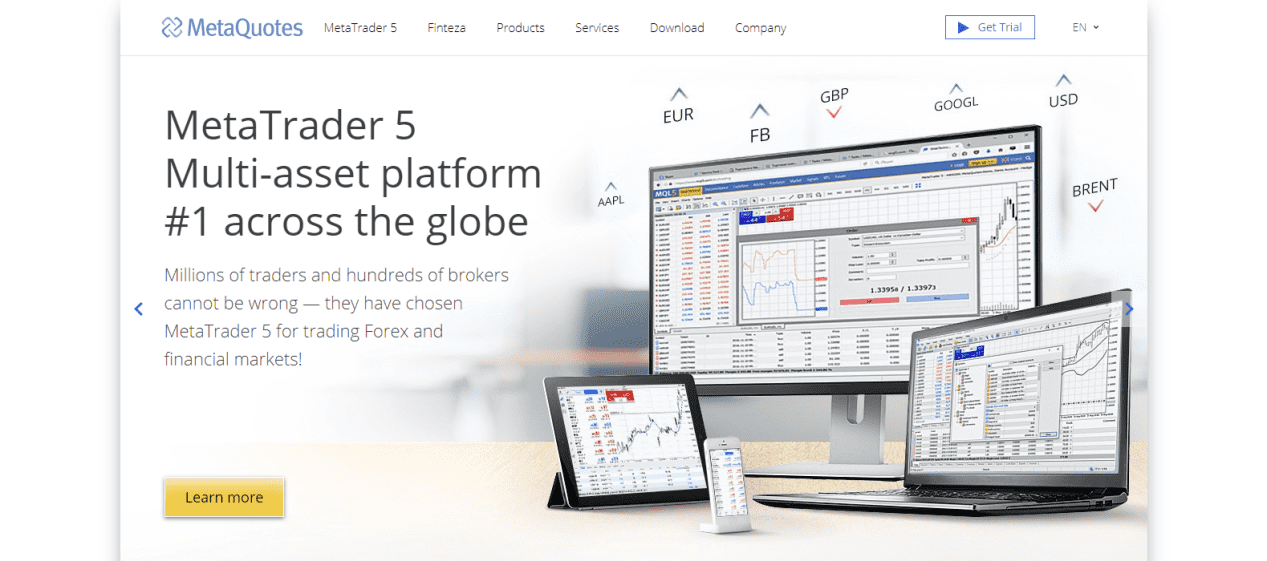
MT5, introduced in 2010 as a successor platform to MT4, enjoys extensive marketing efforts by MetaQuotes and brokers offering it, with little impact. It received an upgrade to the user-interface, speed, addition of more technical analysis tools, and a multi-asset platform. InstaForex became the first broker to offer it to traders in September 2010. Since then, hundreds more have followed, but it remains known as the failed successor platform. MetaQuotes requires a new and more expensive license for MT5, but the biggest reason for its failure is the lack of backward capability to MT4.
Ten years later, it is evident that MetaQuotes underestimated the popularity of the MT4 infrastructure and the mistake in not supporting it. Over 22,000 EAs and scripts will become useless on MT5 and require new programming on the MQL5 language. Since MT4 forms the core of many asset managers who invested heavily in MT4, MT5 faced rejection by the community. Brokers added CFDs to MT4, transforming it into a multi-asset platform. FinTech firms now develop custom trading solutions outside of the MetaQuotes programming language and create a bridge to connect to the MT4/MT5 broker via an API, becoming more independent and flexible. New applications start to flood the MT5 universe, and a slow displacement materialized over the past five years, but as long as MT4 is available, so will be its preference and dominance.
Not all is negative with MT5, and there are ongoing positive developments.
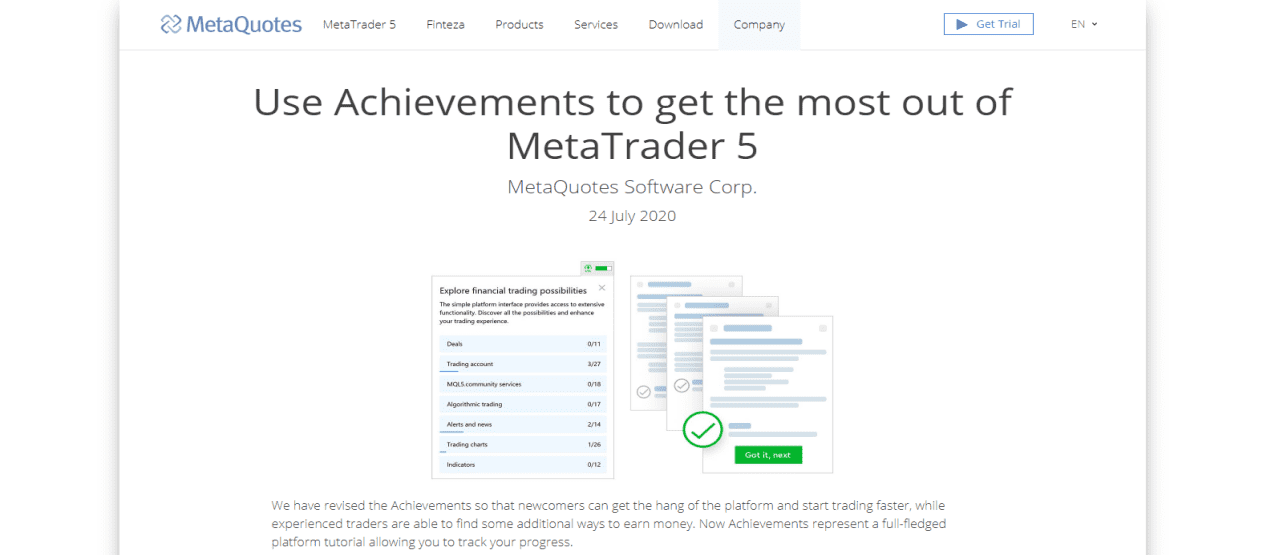
MT5 features a cleaner user-interface, granting it a more modern look. Manual traders have 21 timeframes, 38 technical indicators, and 44 analytical objects to improve market analytics. Hedging and netting are the two implemented order accounting modes. The former is the default setting in MT4, supporting more complex trading strategies, and the latter sums up positions in the same asset, as required by unfavorable trading jurisdictions like the US. One of the most notable improvements is the connectivity to the electronic communication network (ECN) by default. The Depth of Market (DOM) function grants more pricing details, and the financial news section improved. MT5 lists 1,538 EAs, and 2,686 custom indicators, significantly less than MT4, but the trend is growing. MetaQuotes continues to improve MT5, which offers a superior out-of-the-box version as compared to MT4.
How did cTrader gain market share?
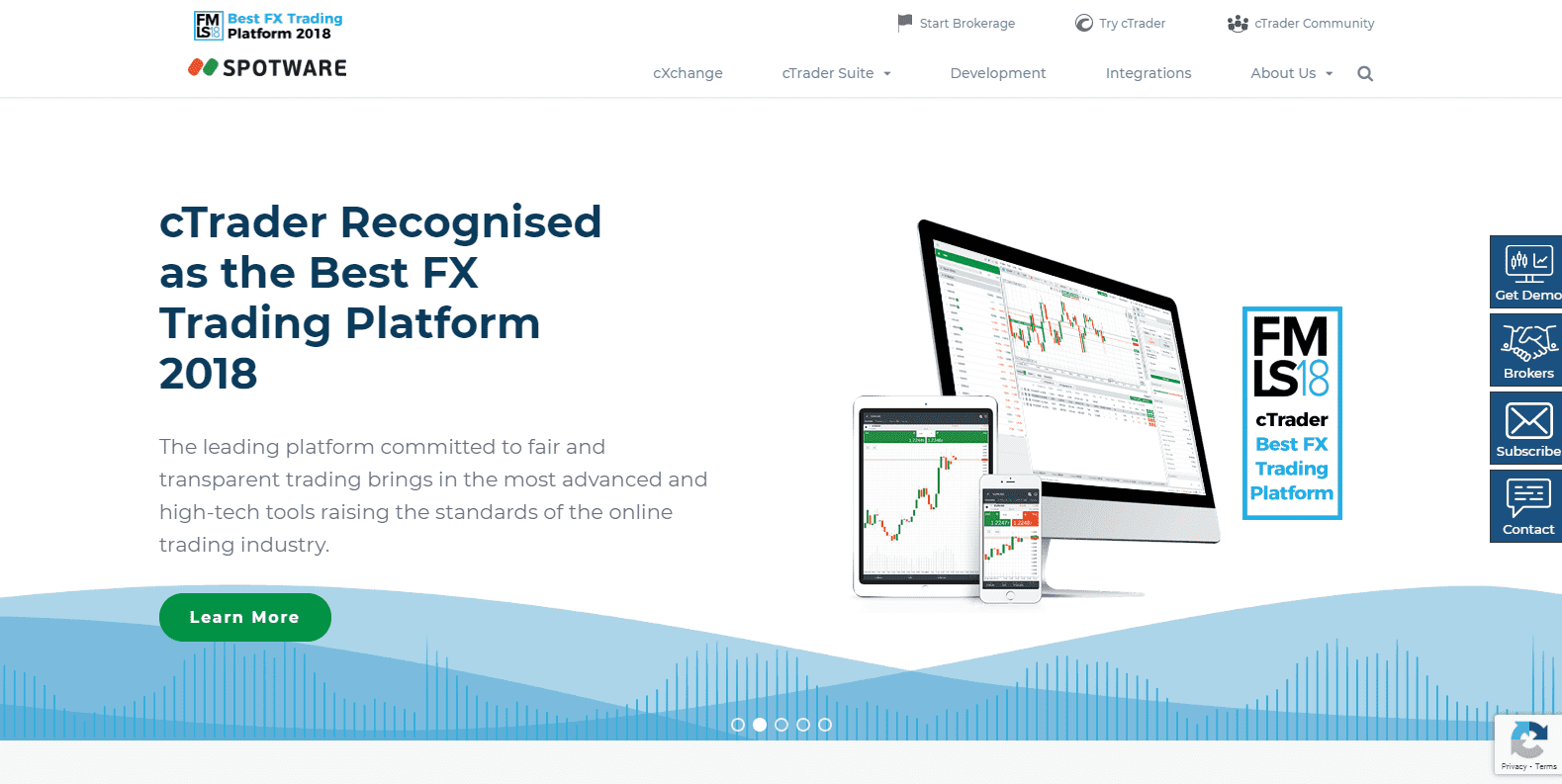
Spotware Systems LTD launched its flagship cTrader in 2010, the same year as MetaQuotes released MT5. cTrader offers the best out-of-the-box trading environment compared to any MetaQuotes version and is an ECN trading platform. The visually appealing design comes equipped with a premium charting upgrade, nine chart views, and over 70 technical indicators. Chart trading abilities, full support for automated trading and custom indicators, and chart sharing via ChartShots add to outstanding core functionalities of cTrader.
Traders have access to Level II pricing, confirming its integration into ECN used by liquidity providers. Fast entry-and-execution of orders, nine order types, volume tooltips, market sentiment indicators, and the symbol info box provide manual traders with all relevant data. cTrader additionally supports social trading via its cTrader Copy. Over 80 financial institutions deploy cTrader, a genuine MT4/MT5 competitor, with a superior foundation.
Developers can create custom solutions in C#.
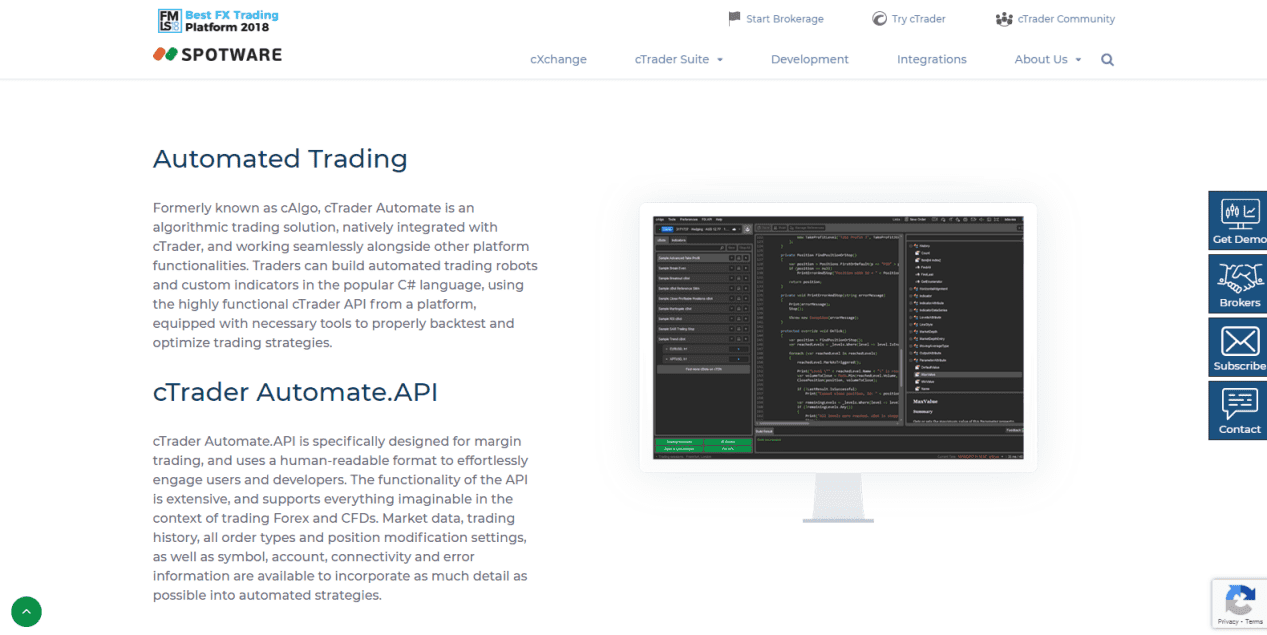
Unlike MetaQuotes, Spotware Systems allows developers to code in C#. cTrader Automate is an all-inclusive algorithmic trading solution, available from the integrated development platform. It features a more advanced testing environment than MT4/MT5 and enables the creation of trading robots and custom indicators. Enhancing the overall product environment and offering additional tools to FinTech companies are cTrader Open API and FIX API. Despite a superior product portfolio, cTrader remains distinctively behind in volume as compared to the two MetaQuotes trading platforms, and the elevated cost limits the number of brokers offering cTrader.
Conclusion - What type of traders benefit from which trading platform the most?
MT4 is a versatile trading platform and an ideal choice for most retail traders. Any trader who can make a small investment to obtain necessary upgrades for the basic version will discover the opportunities offered by the MT4 infrastructure, which remains the core asset of MetaQuotes. It can be fully modified to suit the need of the individual trader. Developers will find a tremendous market, and traders seeking automated trading solutions and custom indicators will be served well with over 22,000 to chose from in the market. Most brokers offer MT4, granting a broad choice, while it also remains the premier choice for retail asset management via PAMM accounts. Thousands of micro and small asset managers developed their business with MT4, supporting the entire financial ecosystem.
MT5 could be a viable option for new traders without the need for existing solutions developed on the MT4 infrastructure. Manual traders may find the sightly improved user-interface reason enough to seek out a broker offering MT5 as a trading platform. Despite the improvements, MT5 requires third-party add-ons, where the choice is notably smaller as compared to MT4. MetaQuotes continues to improve MT5, after ending support for MT4. While promising, it remains insufficient to warrant the necessary investment by brokers to obtain MT5, by existing traders and developers to recode solutions, and by asset managers to rebuild their business on the MT5 infrastructure.
cTrader offers the most user-friendly interface between the three, and the out-of-the-box version is superior. The fewest brokers maintain this trading platform due to elevated acquisition and maintenance costs, but it is more developer-friendly due to its supports C#. It remains more suitable for manual traders due to its supported modules without the need to obtain upgrades. cTrader is dominant in the ECN sector, where a commission structure exists to compensate for raw spreads. Is has been on the market for over a decade, and features more prominent core functionalities together with user-friendliness, but cTrader has not yet enjoyed the success of MT4. It does remain a favorable choice over MT5.
A final thought
MT4 remains the undisputed leader and enjoys a deep user-base, but changes in the trading platform market started to take place. Over the past five years, more innovative small FinTech firms commenced work on innovative trading solutions driven by machine learning and artificial intelligence. Brokers have not yet thrown their support behind any genuine MT4 replacement, as the existing investment is more than enough to offer relevant services. Third-party plugins generally address any MT4 shortfalls, but the trend towards unique trading platforms connecting via APIs to brokers expands, offering genuine competition. MT4 may dominate this decade as well, due to its versatile, low-cost nature. Sophisticated traders will monitor trends in the emerging and competitive sector for new, disruptive entrants, offering an excellent base version without the need to upgrade.
